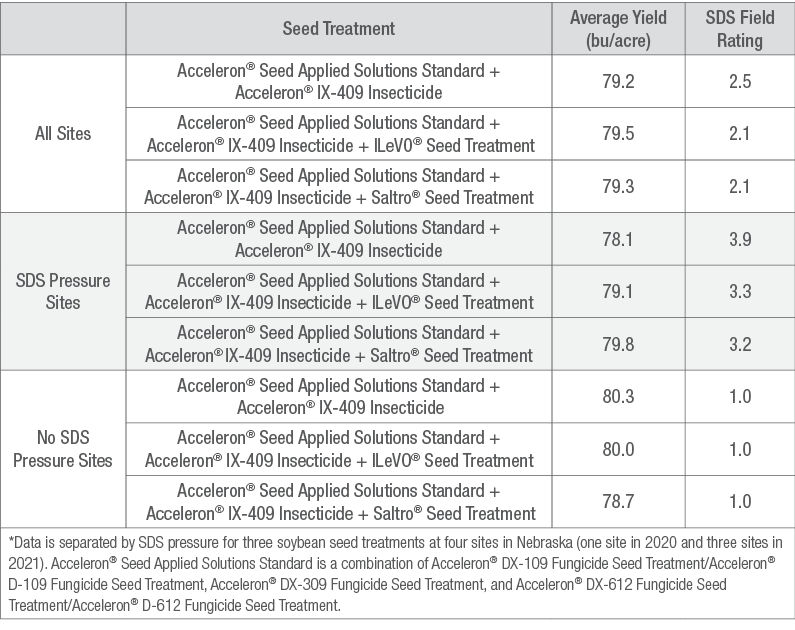5 MIN READ
Managing Sudden Death Syndrome in Soybean
February 9, 2022
TRIAL OBJECTIVE
Evaluate a system-based approach for Sudden Death Syndrome (SDS) management in soybean.
Compare the yield benefit and SDS suppression of three commercially available seed treatments.
Explore the benefits of using a seed treatment along with selecting SDS tolerant soybean products to help maximize yield potential in fields with a history of SDS infestation.
RESEARCH SITE DETAILS
- Trials were conducted over two years at four locations (1 in 2020 and 3 in 2021).

- Trial locations had a history of SDS.
- The trial design was a single replication split plot strip trial where the product was the whole plot and seed treatments were the subplots.
- Typical planting dates for the area were targeted.
- Five soybean products, respectively, were planted at Hooper, NE (Site 2) in 2020 and Battle Creek, NE in 2021. Three soybean products, respectively, were planted at Utica, NE and Hooper, NE (Site 1) in 2021.
- At each location, the soybean products were planted with three seed treatments:
- Acceleron® Seed Applied Solutions Standard* + Acceleron® IX-409 Insecticide Seed Treatment
- Acceleron® Seed Applied Solutions Standard* + Acceleron® IX-409 Insecticide Seed Treatment + ILeVO® Seed Treatment
- Acceleron® Seed Applied Solutions Standard* + Acceleron® IX-409 Insecticide Seed Treatment + Saltro® Seed Treatment.
*Acceleron® Seed Applied Solutions Standard is a combination of Acceleron® DX-109 Fungicide Seed Treatment/Acceleron® D-109 Fungicide Seed Treatment, Acceleron® DX-309 Fungicide Seed Treatment, and Acceleron® DX-612 Fungicide Seed Treatment/Acceleron® D-612 Fungicide Seed Treatment.
- Weeds were controlled uniformly across the study with no foliar insecticides or fungicides applied. Nutrient management was managed by landowner according to their agronomic plan.
- All sites were irrigated using center point pivots
Sudden Death Syndrome field ratings (1 to 9) with 1 = good and 9 = poor based on field incidence and severity were taken at each site at the R6 growth stage (average of three locations within each treatment) (Table 1).
Table 1. Sudden Death Syndrome Field Rating Scale

UNDERSTANDING THE RESULTS
- The combined average yields of the soybean products tested, across the four locations showed no yield response to the seed treatments (Figure 1 and Table 3).

When the data was separated by SDS incidence, the locations with SDS (Table 2) had a positive yield response trend with the addition of ILeVO® seed treatment or Saltro® seed treatment (Table 3).
The locations with no SDS incidence (Table 2) showed no response with the addition of ILeVO® seed treatment and a slight negative trend in yield response with the addition of Saltro® seed treatment (Table 3).
Table 2. Average Sudden Death Syndrome (SDS) Field Rating Across Soybean Products by Nebraska Location*

Table 3. Average soybean yield and Sudden Death Syndrome (SDS) rating across the soybean products used in the trial at each site. *

- The response to individual seed treatments varied by individual soybean product; however, because of the limited replications of each soybean product across locations, analysis was done as an aggregation of soybean products.
KEY LEARNINGS
Sudden Death Syndrome in soybean is a challenging disease to manage and can cause yield loss in fields with SDS incidence.
Selecting soybean products with the highest level of SDS resistance is one of the most important management decisions a grower can make.
Agronomic management such as crop rotation, minimizing compaction, and reduction of excessive soil moisture can help reduce the impact of soybean SDS.
Although no dramatic yield improvement was found with the addition of ILeVO® seed treatment or Saltro® seed treatment, sites with observed SDS incidence showed positive trends in yield response.
A grower should always consult their local sales representative and agronomist to select the appropriate soybean product(s) to help manage the impact of SDS along with optional seed treatments for potentially improved protection.
1007_R3